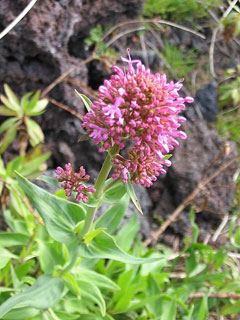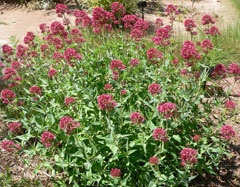 |
|
http://commons.wikimedia.org/wiki/User:Ixitixel |
 |
| http://commons.wikimedia.org/wiki/User:Stan_Shebs |
Translate this page:
Summary
Bloom Color: Pink, Red, White.
Main Bloom Time: Early summer, Late spring. Form: Upright or erect.
Physical Characteristics

 Centranthus ruber is a PERENNIAL growing to 0.9 m (3ft) by 0.6 m (2ft in) at a medium rate.
Centranthus ruber is a PERENNIAL growing to 0.9 m (3ft) by 0.6 m (2ft in) at a medium rate.
See above for USDA hardiness. It is hardy to UK zone 5 and is not frost tender. It is in flower from June to August, and the seeds ripen from July to September. The species is hermaphrodite (has both male and female organs) and is pollinated by Bees, Lepidoptera (Moths & Butterflies).
It is noted for attracting wildlife.
Suitable for: light (sandy), medium (loamy) and heavy (clay) soils, prefers well-drained soil and can grow in nutritionally poor soil. Suitable pH: mildly acid, neutral and basic (mildly alkaline) soils and can grow in very alkaline soils.
It cannot grow in the shade. It prefers dry or moist soil and can tolerate drought. The plant can tolerate maritime exposure.
UK Hardiness Map
US Hardiness Map
Synonyms
Plant Habitats
Hedgerow; Cultivated Beds; East Wall. In. South Wall. In. West Wall. In.
Edible Uses
Edible Parts: Leaves Root
Edible Uses:
Young leaves - raw or cooked as greens[2, 5, 52, 115]. Exceedingly good, either in salads or cooked as a vegetable[4]. This differs from our own experience, whilst the leaves can be added to salads they are rather bitter and rather less than desirable[8, 183, K]. Root - cooked[4]. Used in soups[4].
References More on Edible Uses
Medicinal Uses
Plants For A Future can not take any responsibility for any adverse effects from the use of plants. Always seek advice from a professional before using a plant medicinally.
Miscellany Nervine
Red valerian is sometimes confused in herbals and folk tradition with the true valerian (Valeriana officinalis). Whilst true valerian has a very strong action on the nervous system, this species has no known medical properties[244, 268]. The plant is nervine[148]. This report possibly confuses this plant with the true valerian, Valeriana officinalis, which is a very effective nervine.
References More on Medicinal Uses
The Bookshop: Edible Plant Books
Our Latest books on Perennial Plants For Food Forests and Permaculture Gardens in paperback or digital formats.

Edible Tropical Plants
Food Forest Plants for Hotter Conditions: 250+ Plants For Tropical Food Forests & Permaculture Gardens.
More

Edible Temperate Plants
Plants for Your Food Forest: 500 Plants for Temperate Food Forests & Permaculture Gardens.
More

More Books
PFAF have eight books available in paperback and digital formats. Browse the shop for more information.
Shop Now
Other Uses
References More on Other Uses
Cultivation details
Landscape Uses:Border, Ground cover, Massing, Rock garden, Seashore. Grows well in ordinary moist, well-drained garden soil and on dry walls[1, 111, 200]. Prefers a sunny position[111], though it also succeeds in semi-shade[219]. Thrives on chalk[200], poor soils[188] and in sandy soils[187]. Established plants are drought tolerant[190]. This species is hardy to about -15°c[187, 200]. Plants are generally long-lived and grow especially well in maritime areas, where they are a common feature of hedgerows and walls[219, K]. A very ornamental plant[1], it attracts moths and butterflies[30]. The flowers have an unpleasant smell like perspiration[245]. Special Features:
Attracts birds, Attractive foliage, Not North American native, Naturalizing, Attracts butterflies, Suitable for cut flowers, Extended bloom season in Zones 9A and above, Fragrant flowers. The plant is heat tolerant in zones 8 through 5. (Plant Hardiness Zones show how well plants withstand cold winter temperatures.
Plant Heat Zones show when plants would start suffering from the heat.
The Plant Heat Zone map is based on the number of "heat days" experienced in a given area where the temperature climbs to over 86 degrees F (30°C).
At this temperature, many plants begin to suffer physiological damage. Heat Zones range from 1 (no heat days) to 12 (210 or more heat days).
For example Heat Zone. 11-1 indicates that the plant is heat tolerant in zones 11 through 1.) For polyculture design as well as the above-ground architecture (form - tree, shrub etc. and size shown above) information on the habit and root pattern is also useful and given here if available. The plant growth habit is a clumper with limited spread [1-2].
References Carbon Farming Information and Carbon Sequestration Information
Temperature Converter
Type a value in the Celsius field to convert the value to Fahrenheit:
Fahrenheit:
The PFAF Bookshop
Plants For A Future have a number of books available in paperback and digital form. Book titles include Edible Plants, Edible Perennials, Edible Trees,Edible Shrubs, Woodland Gardening, and Temperate Food Forest Plants. Our new book is Food Forest Plants For Hotter Conditions (Tropical and Sub-Tropical).
Shop Now
Plant Propagation
Seed - sow February to May in situ or as soon as it is ripe in situ and only just cover the seed. Germination is usually rapid. Division in spring. Cuttings, summer, in a cold frame.
Other Names
If available other names are mentioned here
Native Range
TEMPERATE ASIA: Turkey. EUROPE: Ukraine, Krym, Former Yugoslavia, Albania, Greece, Italy (incl. Sardinia, Sicily), Spain (incl. Baleares), France (incl. Corsica), Portugal, AFRICA: Spain, Canarias, Portugal, Madeira Islands, Algeria, Morocco, Tunisia.
Weed Potential
Right plant wrong place. We are currently updating this section.
Please note that a plant may be invasive in one area but may not in your area so it's worth checking.
Conservation Status
IUCN Red List of Threatened Plants Status :

Growth: S = slow M = medium F = fast. Soil: L = light (sandy) M = medium H = heavy (clay). pH: A = acid N = neutral B = basic (alkaline). Shade: F = full shade S = semi-shade N = no shade. Moisture: D = dry M = Moist We = wet Wa = water.
Now available:
Food Forest Plants for Mediterranean Conditions
350+ Perennial Plants For Mediterranean and Drier Food Forests and Permaculture Gardens.
[Paperback and eBook]
This is the third in Plants For A Future's series of plant guides for food forests tailored to
specific climate zones. Following volumes on temperate and tropical ecosystems, this book focuses
on species suited to Mediterranean conditions—regions with hot, dry summers and cool, wet winters,
often facing the added challenge of climate change.
Read More
Expert comment
Author
(L.)DC.
Botanical References
200
Links / References
For a list of references used on this page please go here
Readers comment
| Add a comment |
|
If you have important information about this plant that may help other users please add a comment or link below. Only comments or links that are felt to be directly relevant to a plant will be included. If you think a comment/link or information contained on this page is inaccurate or misleading we would welcome your feedback at [email protected]. If you have questions about a plant please use the Forum on this website as we do not have the resources to answer questions ourselves.
* Please note: the comments by website users are not necessarily those held by PFAF and may give misleading or inaccurate information.
To leave a comment please Register or login here All comments need to be approved so will not appear immediately.
|
Subject : Centranthus ruber
|
|
|
|